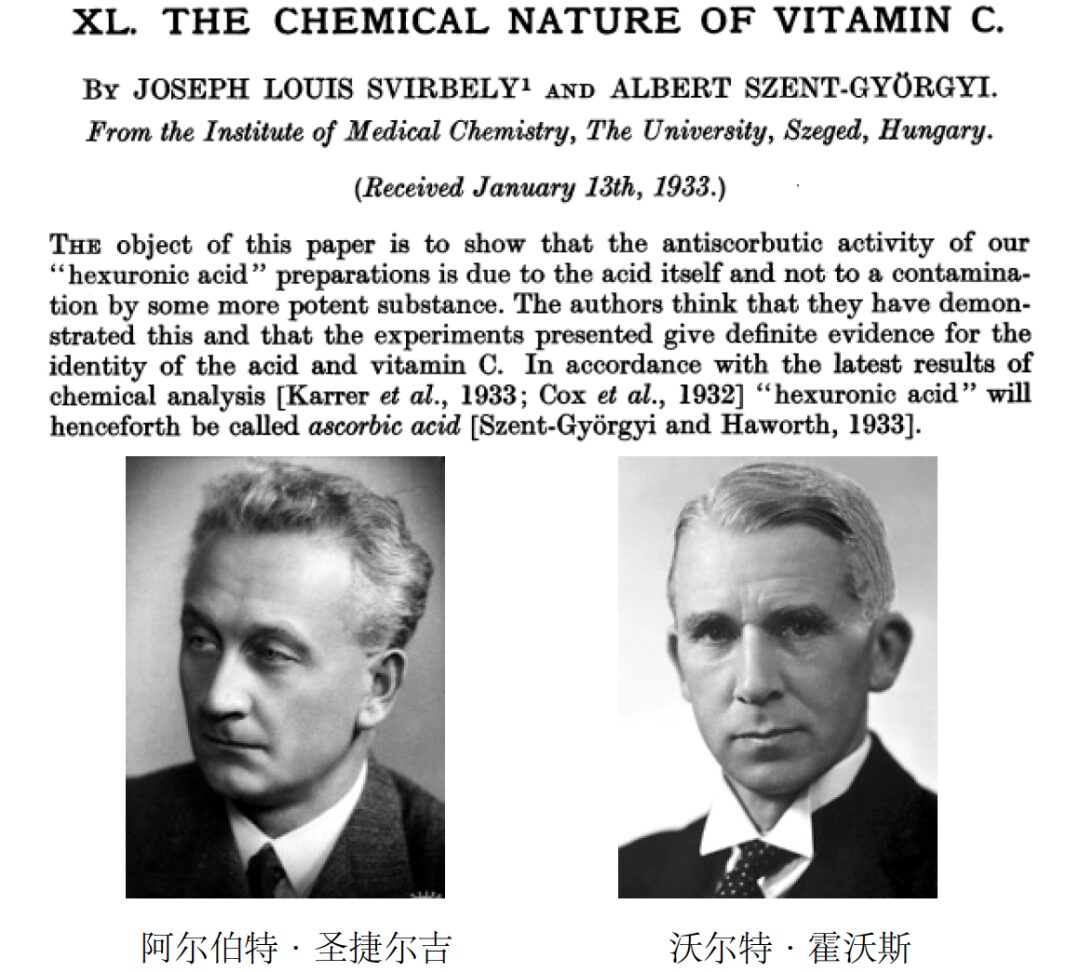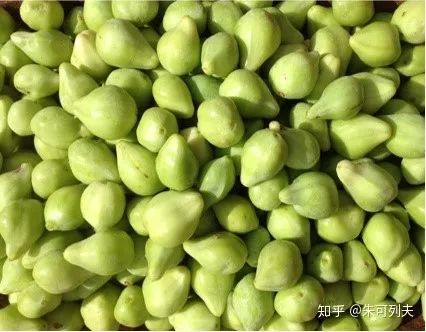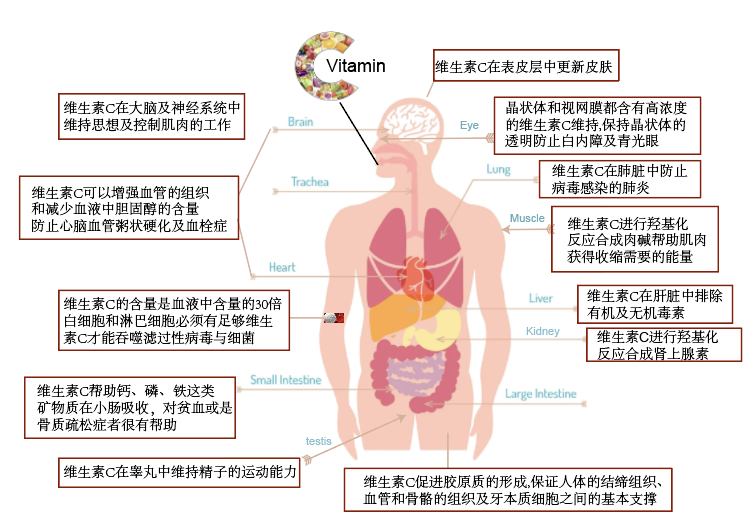Vitamin, also known as vitamin, is a type of organic compound essential for maintaining human life activities. Unlike carbohydrates, fats, and proteins, these substances are not raw materials for body tissue or energy sources but play an important role as regulatory substances in material metabolism. In 1912, Polish scientist Casimir Funk first proposed that certain substances in food could prevent and treat related diseases, which he called vitamins (derived from the Latin word for life (Vita) and the abbreviation for amino (-amin), known in Chinese as 维生素 or 维他命).
The human body requires a small amount of vitamins, often measured inmilligrams or micrograms per day. However, since the body cannot synthesize them or synthesizes them in insufficient quantities, they must be supplied by food. A stable supply of vitamins is extremely important for metabolism, growth, development, and health. Long-term vitamin deficiency can lead to physiological dysfunctions and diseases, such as a long-term deficiency of vitamin B leading to pellagra; a long-term deficiency of vitamin C can cause scurvy; and a diet lacking in vitamin D can lead to rickets or iron deficiency anemia.
Today, we will focus on a well-known and very important type of vitamin—Vitamin C. What is the required amount of Vitamin C for our body? From which foods can we obtain it? Is more intake better?
1. How Was Vitamin C Discovered?
When talking about vitaminC, one must mention vitaminC deficiency—scurvy. The alternative name for vitamin is ascorbic acid, which also indicates the close relationship between the two. Hundreds of years ago, in areas lacking vegetables and fruits or among certain special populations (such as sailors), scurvy was common. Early doctors would alleviate patients’ symptoms through dietary therapy. For example, in1536, French explorer Jacques Cartier used the leaves of coniferous trees to make tea to treat local natives suffering from scurvy during his expedition on the St. Lawrence River; in1617, surgeon John Woodall recommended lemon juice as a “remedy” for preventing and treating scurvy among sailors in his book, The Surgeon’s Mate.
In1747, British Royal Navy surgeon James Lind conducted the first clinical trial to compare and analyze, recommending the use of citrus fruits and fresh vegetables to treat and prevent scurvy.
Although it was observed that consuming fresh foods such as vegetables and fruits could prevent and treat scurvy, it was not well understood which substance was effective. Until1928, Hungarian scientist Albert Szent-Györgyi isolated a pure crystalline substance from vegetables and bovine adrenal glands, which he named “hexuronic acid”. In1932, he, along with British colleague Walter Haworth, proved that the hexuronic acid purified by Szent-Györgyi was the vitaminC that had been sought for over100 years to treat scurvy. They named the chemical name of vitaminC “ascorbic acid”, meaning the acidic substance that prevents scurvy, which has been used ever since.
Due to his research on vitaminC, Albert Szent-Györgyi was awarded the Nobel Prize in Physiology or Medicine in1937, while Walter Haworth shared the Nobel Prize in Chemistry that year with others. Additionally, the research on vitaminC has produced2Nobel Prize winners and numerous large pharmaceutical companies. Currently, China remains a major producer of vitaminC.

The above image shows the paper published by Albert Szent-Györgyi and Walter Haworth in1932. The two images below are of Albert Szent-Györgyi and Walter Haworth respectively.
2. Sources and Intake of Vitamin C
Vitamin C is widely found in fresh vegetables and fruits. Common foods rich in vitamin C includetomatoes, cauliflower, bell peppers, dark leafy greens, bitter melon, citrus fruits, grapefruit, apples, grapes, kiwi, and fresh dates. Compared to many other vitamins, the content of vitamin C in our food is generally relatively high. So far, all plant species have the capacity to synthesize vitamin C, including algae and photosynthetic protists.

Vitamin C is widely distributed in the vegetables and fruits we consume daily, and normal consumption can generally meet our body’s needs, so it is important to eat more vegetables and fruits.
Globally, Australia’s Kakadu plum, South America’s camu camu, and needle cherry are known to be the richest sources of vitaminC. In Europe and Asia, rose hips and sea buckthorn are considered the richest sources of this vitamin. Among fruits and juices, star fruit, guava, black currant, kiwi, and strawberries are excellent sources of vitaminC. As for vegetables, broccoli, kale, and peppers are great foods to supplement vitaminC.

The Kakadu plum from Australia is known to be one of the plants richest in vitaminC, containing ten times more vitaminC per 100 grams of flesh than kiwi and fifty times more than citrus fruits.
Since vitaminC is water-soluble, prolonged cooking, especially boiling in large amounts of water, can cause vitaminC to leach into the water, significantly reducing its content in food. Therefore, it isrecommended to steam or boil in a small amount of water, which seems to be a gentler way to preserve vitaminC. Additionally, temperature greatly affects the stability of vitaminC in food. As the temperature increases, more significant losses occur. In summary, the mildest method for preserving vitaminC in fruits and vegetables over time is deep freezing.
After intake, vitaminC is mainly absorbed in the duodenum and upper jejunum, with some absorption occurring in the oral mucosa and stomach. Unabsorbed vitaminC will go directly to the colon and be broken down into gaseous substances by microorganisms. Therefore, when the body’s absorption capacity is relatively stable, there is no need to consume excessive amounts of vitaminC. The World Health Organization recommends a daily intake of vitaminC for generally healthy individuals to be60-95 mg/day. The “Chinese Dietary Guidelines 2016 Edition” recommends a vitaminC intake of:40-100 mg/day for normal populations according to different ages. Of course, during periods when the body produces a large number of antibodies and complements, such as during pregnancy and lactation, among smokers or those in secondhand smoke environments, and among some chronic disease populations, the demand for vitaminC will inevitably increase.
3. The Amazing Uses of Vitamin C in the Human Body
1. Participates in the Synthesis of Adrenaline
The adrenal glands are the organs in the human body with the highest content of vitaminC. When the body is under stress, the adrenal glands secrete a large amount of adrenaline into the muscles, preparing them to act at any moment to cope with crises. Adrenaline is made from tyrosine (Tyrosine), which is converted into dopamine (Dopa), then into norepinephrine (Noradrenaline), and finally forms adrenaline. Each step of this reaction consumes vitaminC for hydroxylation (Hydroxylation). This explains why both humans and animals must store large amounts of vitaminC in their adrenal glands.
2. Promotes the Synthesis of Collagen
Collagen (Collagen) is a protein that exists in the connective tissue, blood vessels, and between odontoblasts in the human body, serving as the basic supportive substance of animal bodies. VitaminC promotes the formation of collagen. The strength of collagen is due to the consumption of vitaminC, which enhances the intermolecular attraction through the hydroxylation of proline. When there is a deficiency of vitaminC, collagen strength is insufficient, leading to weakened organ tissues and various diseases, with the most severe being scurvy. In normal individuals, the cells of the blood vessel walls are well-organized and ensure tightness due to the presence of collagen. When there is a deficiency of vitaminC, the integrity of the vascular tissue is compromised, and blood can leak out with slight external pressure, which is the most apparent manifestation of scurvy.
3. Assists in Cancer Treatment
Since the 1970s, clinical reports have shown that large doses of vitaminC can help treat cancer, a result that has been controversial. In2017, two top academic journals, Cell and Nature, reported that vitaminC can promote DNA demethylation by restoring the activity of mutated demethylaseTET2, thereby inhibiting the occurrence and development of IDH mutated leukemia. Additionally, it was found that combining vitaminC with approved DNA methylation inhibitors would yield better results in treating leukemia. In simple terms, while the mechanisms of vitaminC in anti-tumor effects require further exploration, there is a theoretical basis for using vitaminC as an auxiliary drug in clinical cancer treatment.
Moreover, vitaminC is widely distributed in various organs and systems in the body, including the lens, retina, muscles, blood vessels, immune system, and liver, making it an essential nutrient for the human body.

Vitamin C plays an important role in many tissues and organs of the human body.
4. Can Vitamin C Really Treat or Prevent Colds?
VitaminC has many benefits, but many people believe it also has the effect of preventing colds, claiming that if taken in sufficient amounts, it can even treat colds. This idea originated in the 1970s when Linus Pauling published a theory that daily intake of 1000 mg of vitaminC could reduce the incidence of colds by about 45%, and that the optimal daily intake of vitaminC to maintain a healthy life and prevent diseases should be at least 2.3 grams. Under the influence of this viewpoint, products like vitaminC tablets and vitaminC effervescent tablets for cold prevention emerged. But do they really have this effect? The answer is no; at leastthere is no experiment to support this conclusion. VitaminC can promote the synthesis of immune proteins and enhance the activity of functional enzymes in the body, thus helping us increase the ability to engulf filtering viruses and bacteria. This is merely an auxiliary method, not that vitaminC can prevent colds.

From a scientific experimental perspective, scientists have determined over decades of research that large doses of vitaminC are ineffective in preventing the common cold but may reduce the duration of cold symptoms. Here are some clinical trial results from several research teams for your reference. In2018, Gómez et al. observed 8472 subjects in a randomized clinical trial and proved that an intake of more than 80 mg/day of vitaminC does not prevent the common cold in healthy adults and children. In2019, Vorilhon et al. conducted a randomized controlled trial, confirming that supplementing vitaminC (doses from 0.5 grams to 2 grams/day) was ineffective in reducing the incidence of upper respiratory infections in 3135 children (aged 3 months to 18 years) compared to a placebo, but supplementing vitaminC could shorten the duration of infections by 14%.
In summary, vitaminC has many benefits for the human body, but it is very necessary to take vitaminC in a reasonable and moderate manner. If vitaminC supplements are taken excessively in a short period, side effects such as excessive urination, diarrhea, and skin rashes may occur; long-term excessive intake may lead to oxalate and uric acid stones; excessive supplementation during childhood growth can easily lead to skeletal diseases; and if one-time intake of vitaminC reaches 2500–5000 mg or even higher, it may cause massive rupture of red blood cells, leading to hemolysis and other critical conditions. Moreover, except for specific individuals and conditions, current evidence is insufficient to support regular supplementation of vitaminC for preventing or treating colds in the general population. Therefore, it is important to take vitaminC rationally, allowing it to safeguard our health.
Editor: Lychee
↓ Click the title to view ↓
